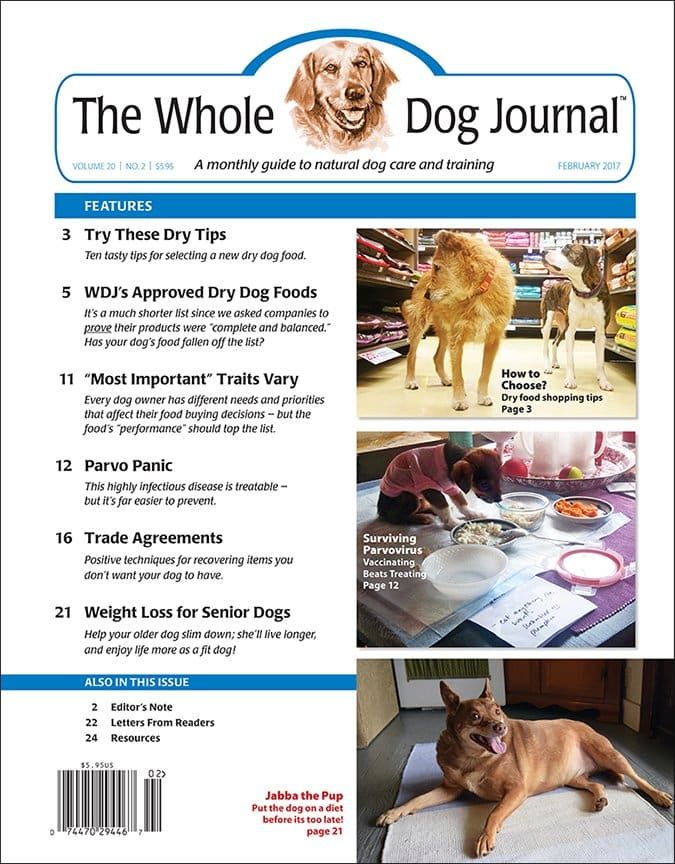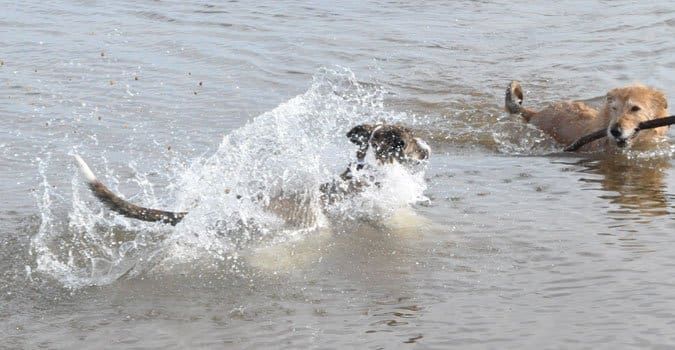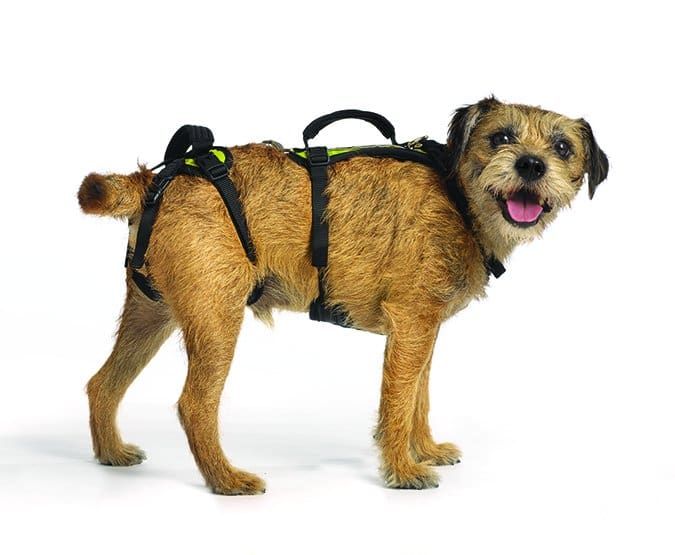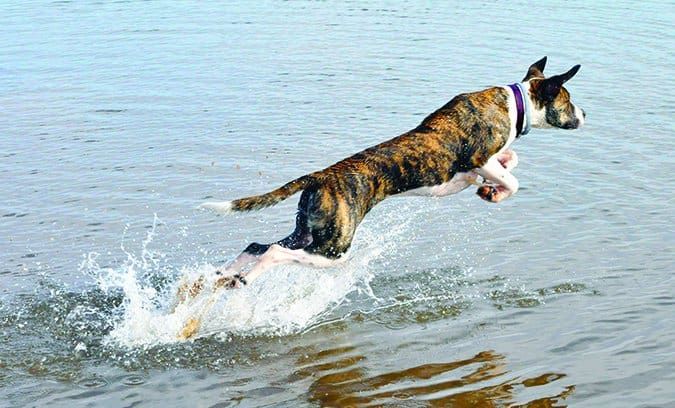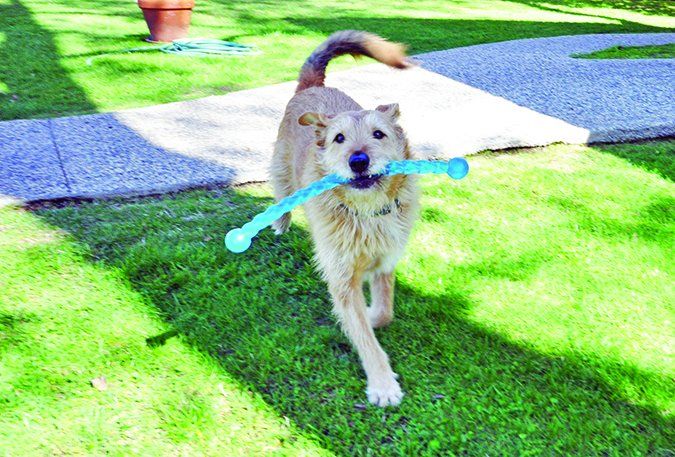Download the Full February 2017 Issue PDF
How Does Your Dog Act When You’re Not Around?
A few years ago, I was dog-sitting for a friend while her family traveled out of the country for a few weeks. I’ve met the dog, Leila, a Papillion-mix, a number of times, but just in short visits.
It was the height of our hot, dry summer during Leila’s visit, and when those conditions are in effect, I often take my dogs to swim in the Feather River, which flows through my town, just a couple blocks from my home. I took some pictures one evening, and posted them on Facebook, of the dogs, including Leila, wading deeply in the water.

Later that day, there was a comment from Leila’s owner: “Leila went in the WATER? She NEVER touches water!” I laughed, because it seemed quite natural to me that she’d go in the water. I didn’t even notice her response to the water; wading in the cold water when the temperature was over 100 degrees seemed like the only sensible thing to do. But Leila’s owner couldn’t get over this behavior, that she had never seen in seven years of owning the dog and taking her to other creeks, streams, rivers, and the ocean.
I bring this up because I’m out of town for two days, and my sister is caring for my dogs. And I just had a report about Woody’s behavior that surprised me. It wasn’t the fact that he had chewed up my hard foam back roller; he’s been eyeballing it for some time as a potential toy, and I do recall I left it on the living room floor. My fault. No, it was the report that when my sister brought him to her house to play with her dogs, he was running through her home so fast that he leaped to the back of her sofa, and his momentum actually made the sofa (which has not one but two recliners hidden in it) fall over backward! WHAT?
My sister was laughing so hard when she was telling me this, that she didn’t hear my consternation at first. PAM! Why are you letting him tear through the house like that? She just kept repeating that she thought it was so funny to see my goofy, exuberant young dog so joyful about the abundance of new toys to play with, and so happy to visit. Pam has been my go-to dog-sitter for Woody since he was a pudgy puppy, and he adores her and her treat- and toy-filled home where (seemingly) everything goes. She never admonishes him for (apparently) ANYTHING! I could see the scene in my mind’s eye, and after I got over my surprise, I had to laugh, too. After all, I know this isn’t anything he’s going to try at MY house.
I’ve asked before, but the answers are so interesting, allow me to repeat the question: Have you ever been surprised by a dog sitter’s report about your dog’s behavior?
Do You Have a Backup-Plan for Your Pet-Care Needs?
I woke up this morning with a blinding migraine headache. It hurt to open my eyes, it hurt to sit up, and getting dressed made tears start running down my face. This doesn’t happen very often, and I have medication that I can take that will bring relief in an hour or so. But lying in bed was not an option, because I’m currently fostering another litter of puppies, and they don’t care whether my head hurts or not: they are hungry, and their pen needs cleaning. That’s a responsibility I took on, and so, weepy or not, I got up and dressed, took my migraine med, and got rolling.
My adult dogs can handle a delayed breakfast, and thanks to the recent installation of a dog door – one of those inserts that fits into a sliding glass door frame – they can and will take themselves out to potty if need be. But foster puppies in a pen are a different matter. By the time I got them out of the dirty pen to potty outdoors, fed them, cleaned the pen and changed the water, and put them back in the pen with some fresh toys, the throbbing in my head was abating a bit.
While I cleaned the pen, I thought about the pet owner’s need for backup. If I was super seriously ill, there are people I could call on to help. My husband and my sister would be my first line of defense. I have dog-loving friends who, given a bit of notice, could come and help before they went to work and afterward.
Because I foster for my local shelter, in a worst-case scenario, I could call the staff and throw in the towel, and an animal control officer could come and collect the puppies and take them back to the shelter. The same is true for the best-run rescue groups; there are enough people helping to keep the load light on any one person. But I’ve heard about plenty of rescue organizations that turned out to be, in reality, just one very disorganized person, and perhaps a few of her friends, struggling under the load of too much to do with not enough resources. When that person gets seriously ill or debilitated, the animals suffer. It’s a situation that every small rescue organization has to look out for and actively prevent.
Another thing I thought about as I cleaned the pen: If I had a stroke or something else sudden, how clear would it be to anyone coming in to help what to do, who to call? I’m sure my husband would figure out to call the shelter and ask for help, but it might not happen right away. However, since I organize all the care for our dogs, would he know where to order their food, which is not available locally? Would he know which vet I bring them to, or the fact that I have pet insurance for them now? I know for certain that he would not!
I think this afternoon I’m going to make it a point to grab the files with their vet records and insurance information, and put them somewhere that he can access them more easily – in our home, not my office – and let him know where they are.
I’m also going to write out some instructions regarding which foods I buy for them and where I buy it. I’ll also include a contact sheet for the shelter staff, so he will know, quickly, who to call if someone needed to come grab my foster pups and get them to someone else who could take over.
Then I thought: What if my husband and I both were in a car accident, coming back from a movie at night? I recently saw a laminated card you can put on your key ring that alerts first-responders to the fact that the bearer has pets at home, and includes an emergency number to call (here’s just one example). I need to get one, and put my sister’s number on there. She has a key to my office, and she knows the shelter staff, so the puppies could be taken care of quickly, but I don’t think she has a key to my house! Nor does she know anything about my dogs’ records; I need to get her a key, show her my file of information on the dogs and where I keep it, and maybe put some cash or a check in the file, in case she needed to cover their expenses for a while.
My husband and I have talked out our wills, but neither one of us has done anything yet about them. We have real estate and bank accounts to deal with – but in my will, I also need to write up my wishes about what would happen to my dogs, and make arrangements for their care. That reminds me: WDJ has a good article on this in its archives. I’ll read that and get going.
Funny where a bad headache can take you.
Do you have plans in place for your pets, in case something were to debilitate you for a day, a week, a month, or permanently?
Resolutions . . . for your dog?
Looking for an idea for a blog post, I just looked through my oldest posts, wondering just how long I have been doing this. The answer stunned me: since mid-2010. I got lost for a bit, reading through musings from years past.

I came across one written at precisely this time of year in 2011, about making new year’s resolutions for our dogs.
I made a couple of resolutions at that time, and here’s another stunner (sarcasm alert): In the past six years, I absolutely haven’t done the two things I said I was going to try to do.

It’s probably smart to make small, achievable goals, instead of the big ones like “I’m going to make my dog’s food and compete in a new sport.” I still want to do both things, but I haven’t made them a priority; lots of other projects have come up that have been pushed to the top of my “to do” lists. But both things are still goals I’m interested in. I have to take some small steps toward achieving them.
Do you have any goals for you and your dog or dogs this year? Any that you’d care to share? They might inspire others to think about and develop some goals for improving their dogs’ lives, too!

Raw Honey for Dogs
Honey is an amazing gift from nature, used for more than a thousand years to promote health and recover from illnesses. It’s loaded with beneficial vitamins and minerals, as well as powerful antioxidants. It has research-proven antibacterial/antimicrobial properties, can calm allergic reactions, and will soothe irritated skin and throats.
Look for “raw” honey, preferably from local beekeepers, rather than the processed product often found on grocery-store shelves. Raw honey is strained to remove debris, but that’s it. It’s otherwise as natural as you can get. Shop at the farmer’s market or do an Internet search for local beekeepers.
Processed honey, on the other hand, is manufactured with heat, which thins it and destroys many of its beneficial attributes. In fact, many processed honey products aren’t even truly honey, as the manufacturing can filter out the beneficial pollen.
Natural honey color will vary from light to dark golden amber, depending on the flowers the bees used to make the product. It’s only a color.
While larger doses are safe, dogs don’t need much honey in order to benefit from its ingestion. A quarter-teaspoon per 20 pounds of body weight daily is enough for health maintenance.
Since dogs enjoy honey’s sweet taste, it’s easy to feed from a spoon or, if the honey is thick, you can roll it into a treat-sized ball. Honey can be fed by itself, mixed with powdered herbs for additional benefit, or added to herbal teas that double as cough syrups. To find instructions on creating your own herbal honey, see “Herbal Medicine for Your Dog,” (April 2007). We’ve read that some people add honey to the dog’s water. If you do that, you should offer plain, fresh water as well.
Dogs benefit from raw honey in the following ways:
1. Raw honey provides allergy relief to dogs.
Medical research supports the use of local honey to combat environmental allergies. Note that we said local honey. A local product contains tiny amounts of the pollen in your area, so that when your dog ingests the honey, his body can adjust to the potential allergens gradually, which should help prevent a full-blown attack. Hint: Be sure you’re dealing with an environmental allergic reaction. Itching, scratching, and hot spots can also indicate a food allergy. See “Suspect Your Itchy Dog Has a Food Allergy?” (March 2015).
You can even take things a step further in your quest for allergy relief. Texas beekeeper and dog trainer Michele Crouse washes her dogs with it. “I start with a clear, natural shampoo base from an organic supplier,” she says, “and mix it with an equal amount of honey to which I’ve added aloe vera and essential oils like lemongrass, orange, lemon, lavender, tea tree, citronella, and the Asian herb May Chang (Litsea cubeba). All of these plants have disinfecting, deodorizing, or insect-repelling properties. The essential oils make up about five percent of the formula, so it’s safe for adult dogs and older puppies. To dilute the shampoo and make it easier to use, I add about 25 percent water.”
The resulting shampoo doesn’t lather much, Crouse says, but it cleans the dog well and soothes the skin. “I let it stand for a minute or so, rinse it off, reapply, and then give a final rinse. I board dogs, and if a visiting dog is scratching and itching, I’ll give him a bath in honey shampoo, and that always helps.”
2. Raw honey soothes symptoms of kennel cough.
Honey is a time-honored solution for soothing irritated throats and coughs. For kennel cough, you can use local honey, but Manuka honey may be your best choice. Made by bees pollinating the Manuka trees in New Zealand and parts of Australia, Manuka honey has the highest antibacterial properties of any honey in the world. It’s also the highest-priced honey in the world, and may cost three or four times what you might pay for local honey.
3. Raw honey helps heal dogs’ burns, scrapes, and cuts.
Manuka honey is also a top choice for a natural wound dressing. In fact, Manuka honey is FDA-approved for use on human burn patients. But any raw honey will help keep the wound area clean and moist, which promotes healing. Honey’s natural antibacterial properties reduce the chance of infection and protect the injured area.
After cleaning the wound, spread on a thick coat of honey and then apply a light bandage, if necessary. Of course, you may have to also use an Elizabethan collar or similar device to stop your dog from licking the area!
Note: Deep, wide or puncture wounds should always be examined by a veterinarian before applying any medicine.
4. Raw honey reduces gastrointestinal upset in dogs.
For minor bouts of an upset stomach or diarrhea that might come from something simple, such as your dog feasting on fresh grass, a couple of doses of honey may help quiet and soothe his GI tract.
Some veterinarians suggest honey to help control minor stomach ulcers, since honey’s natural antibacterial properties can help destroy bacteria that may be causing the ulcer.
Again, you need to be certain about what you’re dealing with, so seeking veterinary advice in these situations is wise.
5. Honey lends an energy boost to dogs.
Honey is a sugar, and sugar boosts energy. Anecdotal evidence shows that honey helps many older dogs regain some of their former spunk and drive. Many owners of canine athletes use honey to promote energy, endurance and vitality.
Tips for Feeding Your Dog Honey
All honey is thick, but honey that has crystallized is usually too thick to pour or even scoop out. It can be softened by putting the jar in a bowl of hot tap water. The water should reach about three-quarters of the way up the jar. Let it sit for five to 10 minutes, stirring occasionally after the first five minutes. This method will soften the product without harming it because you’re not using too much heat. Do not use a microwave or put the honey in boiling water on a stove top. Store honey at room temperature in a tightly sealed jar.
Potential Problems with Feeding Honey to Your Dog
Honey contains 64 calories in a tablespoon. While that may not seem like much, it’s a relative thing, depending on your dog’s normal weight and his activity level. Unwanted weight gain can result from the addition of a daily dose of honey, if other adjustments are not made (i.e., reducing other treats or the amount of food your dog receives).
Heads up: If your dog is diabetic, discuss the use of honey in his diet with your veterinarian. Honey is a simple sugar.
A final caution: Do not give honey to puppies. Natural, raw honey can contain very small numbers of Clostridium botulinum spores, which can be found in dirt and dust. The mature digestive systems of adult dogs (and humans) can move the spores through the body before they cause any harm, but puppies (and babies) can become sick from ingesting the spores. Save honey treatments for dogs who are more than a year old.
Here are some more reasons to use caution when administering honey. Ultimately, however, raw honey is safe and beneficial to adult dogs.
For an in-depth survey of all the ways you can use honey and other bee products for dogs, read “Bee Products Have a Special Meaning for Dogs,” (September 2007).
Cynthia Foley is an experienced freelance writer and dog agility competitor in upstate New York. Her last piece for Whole Dog Journal was “Reduce Your Dog’s Cancer Risks” in August 2016.
Disabled Dogs Products
[Updated January 15, 2018]
If your dog has arthritis or is recovering from an injury or has a condition that restricts her range of motion, a variety of assistance devices ranging from simple to sophisticated can help her live a more comfortable, active life.
Dog Steps and Ramps
Steps and ramps are affordable, portable aids for dogs who need help getting onto or off of furniture or into and out of vehicles.
If your dog needs only a little help with a few stairs, nonskid strips from a home-improvement store may provide all the support she needs.
Longer distances, such as from the floor to a bed or sofa or from the ground to your car seat or the back of your SUV, may require a ramp. For a wide assortment of pet steps and ramps, search for these items at Amazon.com, Chewy.com, Wayfair.com, and other retailers.
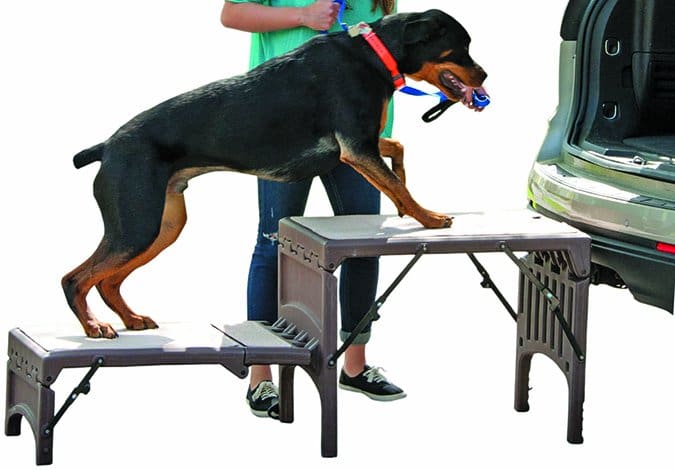
Study products and their return policies carefully, for not all pet ramps and steps are stable, comfortable, or safe for your dog. As Michael Petty, DVM, explains in Dr. Petty’s Pain Relief for Dogs (Countryman Press, 2016), “If your dog needs a ramp for two or three steps, I recommend that you invest in a custom-built, semi-permanent ramp.” That’s because temporary ramps are often wobbly, many dogs refuse to use them, and temporary ramps can slide out of position, injuring you or your dog. Several websites offer do-it-yourself construction plans for ramps and pet steps.
Depending on your dog’s condition, a ramp may be so steep that it stresses the spine or painful joints, in which case a large step arrangement may work better. For examples, see the Free Standing Foldable 2-Step Pet Stair by Pet Gear or the Pet Loader dog steps.
Look for a step or ramp that is easy for you to position, wide enough to be stable, sturdy enough to support your dog, and which has a durable nonskid surface. If the configuration is unfamiliar to your dog, introduce it gradually with plenty of rewards and encouragement.
Elevated Dog Bowls
We’re not usually fans of elevated bowls, because studies have shown that raised bowls can increase the risk of bloat in large breed and other susceptible dogs. For dogs with neck or spine injuries or osteoarthritis, however, elevated food and water bowls may help reduce pain (or anxiety about pain) from reaching down to eat or drink from low bowls. Some elevated bowls come with adjustable legs, so you can experiment to find the best height for your dog. Search online for “raised dog bowls” or “elevated feeding stations,” or ask your independent pet supply store to order one for you. The ProSelect Adjustable Dog Diner ($50 from Amazon) is an example.
Orthopedic Dog Beds and Bed Warmers
Beds are not really assistance devices, but they are important because our dogs spend most of their lives lying down. An uncomfortable bed can worsen a painful condition and interfere with restful sleep.
For mattress-shopping advice, see “The Best Orthopedic Dog Beds,” (March 2016), which describes nine leading orthopedic dog beds. Consider basic structure, mattress thickness, how much support the mattress provides, whether the cover is removable and washable, and whether your dog sleeps curled up in a snuggly ball or stretched in all directions. Whole Dog Journal recommends ignoring bed sizes defined by breed or weight. Instead, measure your dog from nose to tip of tail and from toe to the top of the shoulder. Then order a bed that’s at least 12 inches longer and wider than the dog’s measurements.
Bed warmers can provide warmth and comfort to aching joints. Examples include HipHugs, which are rice-filled blankets that can be warmed in a microwave and placed across your dog’s hips or joints, and Buddy Bags, a similar product from DogLeggs. Another similar product, the K&H Microwavable Pet Bed Warmer, is a neoprene bag filled with a nontoxic liquid that stays warm for hours after microwaving. It’s meant to be used inside a dog bed only.
Improving Foot Traction for Dogs
Sliding or skidding on a slippery surface is more than inconvenient; it can be a health hazard for older, three-legged, arthritic, or injured dogs.
CarpetSaver makes lightweight, nonskid, soft-fabric floor and carpet protectors that provide extra traction for pets and people. They come in different shapes, colors, and sizes, and are easy to move and machine washable. Placing yoga mats on a floor’s slippery areas is another way to improve traction.
Nonskid socks for dogs, which are similar to nonskid socks used by hospital patients, help dogs maintain their balance on wood, vinyl, and tile floors. For examples, see Drs. Foster & Smith Rubber Bottomed Knit Dog Socks, Ultra Paws Doggie Socks, or Power Paws by Woodrow Wear. A fabric paint or rubber material applied to the socks prevents slipping. Look for nonskid patterns that extend up the sides so that if the socks twist on your dog’s feet, they will still prevent slipping and sliding. Buying the right size is important because a too-large sock won’t stay on. Follow measuring instructions.
Disposable balloon socks, such as Pawz, are rubber socks that improve traction on slippery surfaces, but because they don’t breathe, they can trap moisture and lead to yeast infections if left on all day. For best results, remove them after exercise.
Dr. Busby’s ToeGrips are small, non-slip rings that fit over a dog’s toenails, adhere by friction, and grip the floor. ToeGrips work best on dogs who don’t drag their feet because of an injury or neurological disorder. Watch the before-and-after videos on the ToeGrips website!
Paw-Pads are nonskid adhesive bandages shaped to fit a dog’s paws. Because they are thin and allow the skin to breathe, dogs don’t usually notice them. These stick-on traction aids, which are said to stay in place from two to 10 days depending on weather and activity, are recommended for all dogs, including those with neurological deficits that cause feet to rotate. Available from Pupgear Corporation and other online retailers.
Rosin, a solid resin from pine and other evergreen trees, is used by tennis players and gymnasts to keep their hands from slipping. Rosin products for human athletes or sprays labeled for canine use, such as Bio-Groom Show Foot Professional Anti-Slip Spray, can be applied to your dog’s paw pads. Rosin has to be reapplied as needed and doesn’t protect as well as nonskid socks, but can be helpful for dogs who don’t like socks or keep taking them off.
Dogs with long hair between their toes lose traction, too, so keep the feet groomed by trimming foot hair as well as toenails.
Dog boots, as described in “The 4 Best Winter Dog Boots Out There,” (November 2016), provide warmth, traction, and protection from slippery ice, snow, and other outdoor hazards.
Body Lift Harnesses for Dogs
Sometimes dogs need help going up a flight of stairs, getting into a car, or just walking from one place to another. Support harnesses can make this job more convenient and comfortable for both you and your dog.
Some harnesses feature a single front handle while others have one at the shoulders and another above the hips. A front-handle harness takes care of most situations, but a two-handled harness helps dogs rise from a prone position and provides extra support on stairs, when getting into or out of vehicles, or when in pain because of hip dysplasia, illness, or injuries.
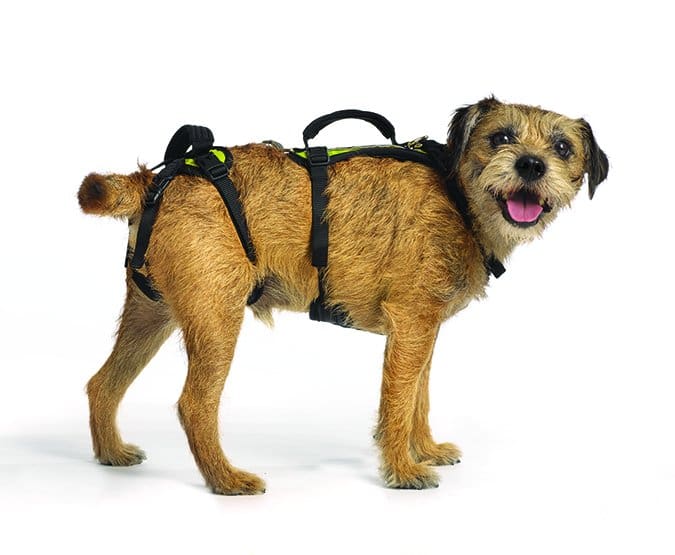
Ruffwear’s Web Master Harness is a single-handle harness designed to assist dogs up and over obstacles. According to Ruffwear’s website, the harness, which comes in two colors and five sizes, “is the preferred dog harness used by many avalanche rescue dog teams in the United States. This harness makes a great collar alternative and is ideal for hiking, scrambling, and mobility assistance.” This harness primarily supports the front end and middle of the dog. The Web Master harness sells for $60.
Ruffwear also makes a harness that adds support for the dog’s rear end. The Doubleback harness ($125) is meant for lifting and lowering dogs on mountain climbing adventures, so it’s strong and comfortable, and could certainly be used to support a dog who was wobbly on his legs. Ruffwear sells its products directly as well in select pet supply stores.
There are also a number of products made specifically for mobility support. The Help ‘Em Up Harness consists of separate front and back sections, each with a well-designed, comfortable handle. With 11 separate adjustments, it’s more complicated than most harnesses, but the website video, printed instructions, and fully assembled delivery make it easy to use as well as versatile.
I purchased a Help ‘Em Up Harness for a friend’s Labrador Retriever five years ago when he stayed with us in his old age, and later adjusted the same harness for my own Lab when a muscle injury made stair climbing painful. The Help ‘Em Up Harness comes in five sizes and offers two hip lift designs to accommodate male anatomy.
See more harnesses described in the Whole Dog Journal article “Orthopedic Equipment for Dogs Designed for Increased Mobility and Extra Support,” (March 2011).
Braces and Other Mobility Support Products for Dogs
Splints, wraps, braces, orthotics, and prosthetics can help dogs with disc disease, joint problems, cruciate ligament injuries, and other conditions that interfere with mobility. Most of these products are sold through veterinarians.
Thera-Paw Assistive and Rehabilitative Products include splints and wraps that support legs and joints.
The Woundwear A-Trac Dynamic Brace for dogs with cruciate ligament injuries was designed for use before, after, or instead of surgery to support and strengthen the leg.
Therapeutic Dog Hock and Leg Wraps from Back on Track are said to relieve pain and inflammation, help injuries heal, and ease arthritis pain.
Ortho Pets makes custom orthotic and prosthetic devices, including Hoppy and Wheelie Vests for dogs with or without the use of their front legs.
For dogs unable to use their hind legs, canine wheelchairs include:
For additional information see Handicapped Pets and Dog Mobility.
CJ Puotinen is the author of The Encyclopedia of Natural Pet Care and other books.
Shaping Your Dog’s Behavior
Like many dog trainers who use and teach dog-friendly training, I’m a huge fan of the dog training technique called “shaping.” In a nutshell, shaping requires clearly defining the end behavior that you want your dog to learn, and starting the training process by identifying the smallest, easiest criteria that you will mark (with a discrete signal, usually the “click!” of a clicker) and immediately reward (usually with a small, delicious food treat). The rest of the process involves systematically adding criteria – or levels of difficulty – to the behaviors your dog offers (in order to elicit your click and treat). The goal is to gradually encourage your dog to make his way toward the end behavior – your goal behavior.
I love shaping because it’s completely force-free, rewards the dog for being creative and showing initiative, and because it’s just plain fun to watch as a dog excitedly works out the answer to a puzzle presented to him by his handler.
Novice trainers and dog owners also usually find shaping to be really exciting and fun – at least, at first. When someone is first shown how quickly she can get her dog to do something complicated, without ever saying a word or pushing or pulling or coercing the dog in any way, most people start using it to try to teach their dogs all sorts of things, from the basics like sit, down, and targeting (touching something with a nose, paw, or other body part), to more complicated things like turning on light switches and learning fancy freestyle dance moves.
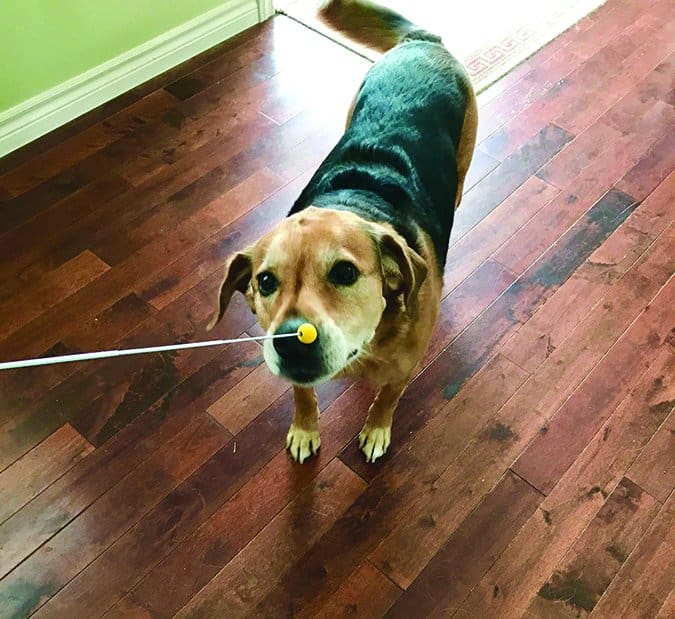
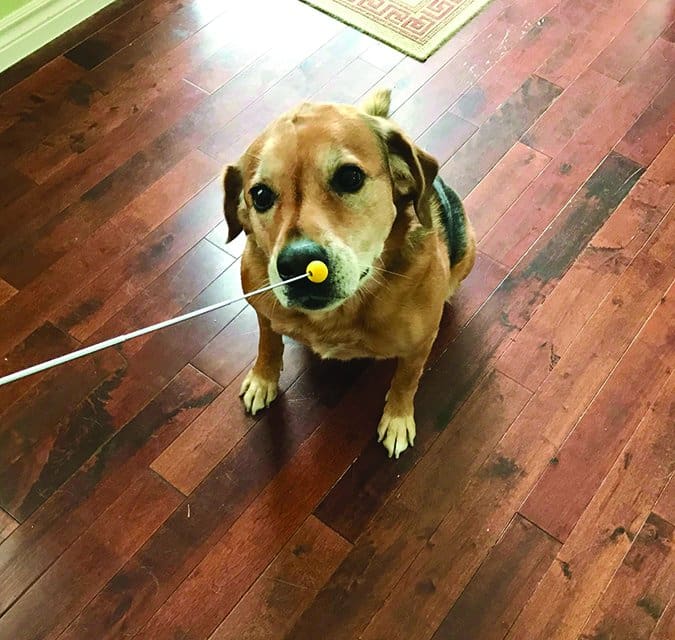
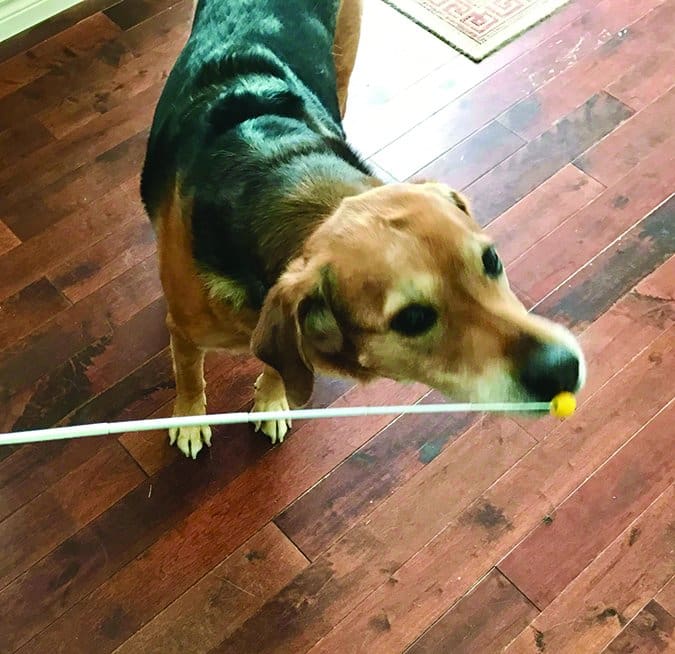
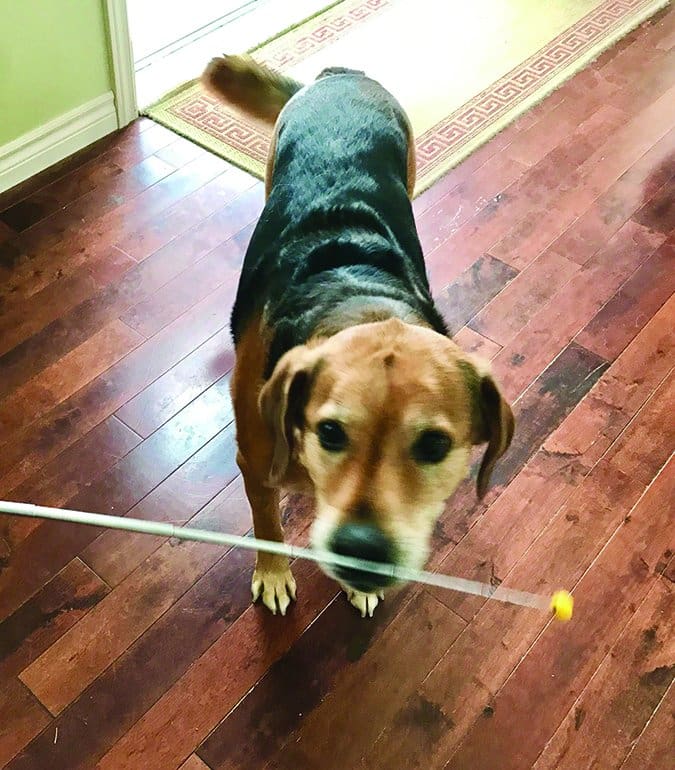
Confusion and Frustration are the Enemies of Dog Training with Shaping
The excitement, however, can be short-lived. In their enthusiasm for their newfound ability to get the dog to offer all sorts of behaviors, and their dog’s apparent quick progress, some people can inadvertently become sloppy trainers and expect too much too quickly from their dog – and then suddenly everything falls apart. The trainer can elicit all sorts of behavior from the dog, just not the ones she wanted . . . or she gets the right behavior, but only randomly, not reliably enough to “put it on cue.”
Just as often, frustration can easily develop. Like a player in a game of charades who can’t guess the answer no matter how many clues he’s given, the dog gives up and quits playing the game.
When confusion or frustration set in, and the pair has lost confidence and interest in the game, I like to use a very specific practice exercise to restore both my client’s success at this valuable technique, and her dog’s understanding and enthusiasm for shaping.
When Dog Trainers Lose Focus
In my experience, when things start to fall apart during shaping sessions, it’s most often because the handler gets distracted or loses focus. Shaping requires a lot of mental multi-tasking on the part of the trainer, and if you’ve ever engaged in multi-tasking, you know that the more skilled you are at performing each individual task on its own, the easier it is to try to juggle them all at once.
When a trainer loses focus during a shaping session, it is usually tied to her own enthusiasm; she gets overly inspired or amused by some of the various behaviors the dog offers, and she either skips some important steps and tries to race to the finish line, or sometimes even changes the end goal behavior she’s trying to get the dog to perform, in midstream!
Dog Training Basics for Shaping Success
The best way to counteract these stumbling blocks is to go back to basics and work on some of your training mechanics. Just as athletes will do exercise drills or musicians will practice scales to perfect their skills, trainers need to practice their mechanics. How sharp your training skills are will determine how quickly your dog figures out what it is you want him to do. You need to be able to:
1. Notice the exact moment your dog does the behavior you’re looking for, whether it’s an ear flick or a paw lift. That means you need to sharpen your observation skills to make sure you don’t miss it, especially since many of these behaviors are very tiny and very fast.
2. Click at the right moment. Your timing needs to be spot-on to help your dog recognize exactly what movement earned him that click.
3. Be quiet. Don’t talk, don’t move. You want the click to be the only thing that provides any relevant feedback for your dog (followed by a treat to reinforce, of course). Otherwise, any other stimulus on your part risks eclipsing or overshadowing the information you want to relay to your dog.
While these three skills are crucial to clicker training, perhaps the most important (and often underestimated) element of this training method is the ability to break down the path to the desired behavior into small steps, or “criteria,” and then stick to that path as closely as possible.
For example, the various steps or criteria to achieve “Go to your mat” – where the end behavior is your dog lying down and staying on his mat – might look something like this:
You and your dog are standing close to his mat. You have a pouch full of treats and a clicker. Your dog is likely staring at you (or the treat pouch). You want him to interact with the mat, but he’s extremely focused on you at the moment. In order to get the process moving, you’ll need to find the smallest, easiest criteria that you can reinforce.
1. Your dog’s ear flicks in the direction of the mat. Click/treat (C/T)!
2. Your dog’s eyes glance fleetingly toward the mat. C/T.
3. Your dog’s snout turns in the direction of the mat. C/T.
4. Your dog’s head turns toward the mat. C/T.
5. He turns his head and begins to lift a paw toward the mat. C/T.
6. He turns his head, lifts a paw, and turns his shoulders toward the mat. C/T.
7. He takes one small step toward the mat. C/T.
You see where this is going. Before launching a training program to achieve an end behavior, it’s helpful to have these steps – or sessions – thought out in advance, so you have an idea of the criteria you’ll be looking for. On paper, it always looks as neat and orderly as the list of criteria for “Go to your mat.” In real life, it’s not always so linear and often doesn’t always progress quite as we thought it would. Keep in mind that shaping requires flexibility and the ability to think on your feet. For the purposes of the following practice drill, however, the emphasis will be on slowing things down and maintaining your focus.
Curbing Your Distractions While Training
If you’re still not sure why it’s helpful for trainers to sharpen our focusing skills, consider how multi-tasking without proper focus can go ridiculously wrong. This true-life scenario involving my recent attempt to eat a snack evolved into a comical event that many people can relate to – random task juggling. We’ve all done it! We start with the intent of tackling one task and are easily distracted by another task that we decide needs our immediate attention, followed by yet another task, and so on and so on, until we’re left with a trail of unfinished tasks behind us. At the end of the day we feel we’ve been extremely busy, and yet we haven’t actually accomplished anything.

I had a simple goal: To eat an orange. Instead, I allowed myself to become distracted with various other tasks, one after the other. My parade of behaviors started when I walked into the kitchen in the morning to get an orange. Before getting one from the fruit bowl, I reached for a sheet of paper towel for the orange peel and noticed we needed a new roll.
I walked to the laundry room where we keep the replacement rolls and noticed a stack of folded laundry that needed to be taken upstairs. I forgot about the paper towel roll and carried the folded laundry to the bedroom upstairs. On my way to the bedroom, I glanced into my office, where I noticed some new email notices had popped up on my computer screen. I put the folded laundry on my filing cabinet and sat down at my desk to reply to the emails, which took a while, and I became thirsty. So I walked downstairs to get a glass of water from the kitchen and I remembered my orange!
I should have stuck to one task (eat my orange!), or at the very least, completed each task as I came across it. Instead, I got sidetracked and engaged in a list of unrelated behaviors that in the end didn’t accomplish much.
It’s very easy to become this distracted during a shaping session, causing confusion and frustration for your learner, and disappointment for you, the trainer, when you don’t reach your end goal. If you come back to the basics now and then, and do a few focus practice drills, sticking to a steady and systematic approach to choosing and increasing criteria, you’ll end up enjoying the sweet, juicy taste of success much sooner!
Shaping Drill – Focus Your Dog!
Each of the steps outlined in the plan above represents a criterion – a step toward the end behavior. To sharpen your focus and to avoid wandering off the path, treat each criterion as a short, separate shaping session.
Select a criterion, set a timer for 30 to 60 seconds (or count out a certain number of treats that you’ll use to reinforce that criterion and only that criterion), and focus like a laser beam on marking and reinforcing that behavior only during that shaping session.
For example, say that in a specific, one-minute-or-less session you decide you’re going to look for and C/T a head turn. Good; focus on that and nothing else in that single session. It might be tempting to jump on the opportunity to C/T a new and unexpected behavior that your dog offers, but for now, help your dog understand precisely what it is he’s doing right by keeping your focus lean and clean.
When your time is up or your treats are gone, take a short break to think about what your next criterion will be.
Remember to let the dog know that the session is finished so that he doesn’t inadvertently continue to offer you behaviors that you’re not even paying attention to anymore. To end a session, I like to say “All done!” and play with the dog for just a few seconds.
During this practice drill, if you decide at the very start of a short training session that you will look for, mark, and reinforce a head turn, you must resist the temptation to pile on criteria mid-session just because the dog is offering them randomly, or because these new behaviors look more interesting or are a step ahead of the one you originally had in mind.
Pick one criterion and focus, focus, focus! If you think of another behavior you’d like to add to your list of criteria, make a mental note and work on it later. Keep in mind that the more you practice shaping techniques with your dog, the better he’ll become at offering different behaviors to figure out what you want, and the more likely he will learn to anticipate the direction of where a session is going. Until then, keep your communication as a trainer as clear, clean, and concise as possible.
Shaping a Fast-Learning Dog
Shaping is about marking and reinforcing tiny steps toward an end behavior. While the progress should unfold systematically, sometimes the dog guesses the end behavior much faster than we anticipated. This is more common with dogs who are trained regularly using a shaping technique. They learn to anticipate that we will want more from them, and they’ll offer truckloads of different behaviors in rapid-fire succession until they get the feedback they’re listening for: “Click!”
Many canine veterans of shaping sessions also learn that when there’s a prop or accessory present, they are probably supposed to interact with it, whether it’s a target stick, box, mat, or any other novel item. If you’re using a prop – whether with a dog who’s a shaping rookie or with a seasoned clicker-training veteran – make sure you’re ready to mark and reinforce any interaction with it from the nanosecond you present your prop. Have your thumb on the clicker and your treats nearby, and keep a close eye on your dog. You don’t want to miss anything!
If your dog guesses the end behavior very quickly and offers it repeatedly, you can jump ahead to the following steps:
1. Add a Cue. If the end behavior is for your dog to go lie down on his mat and he’s offering it consistently and correctly, go ahead and let him know what that behavior is called.
To add a verbal cue, say the cue immediately before your dog does the end behavior. For example, if the end behavior is for your dog to lie down on his mat, you can say, “Go to your mat” at the precise moment that he lowers himself into a “down” position on the mat. Over several more repetitions, gradually begin saying your cue earlier. For example, begin saying it immediately before he lowers himself into a down, while he’s still standing. Then begin saying it as he steps onto the mat; then as he’s walking toward the mat.
2. Increase the quality of the behavior. As an additional challenge, you can fine-tune the quality of the behavior by raising your criteria a bit. “Quality” includes features such as duration and speed.
For example, continue shaping to get a longer-lasting “down” on the mat by delaying the click/treat by short increments. Or increase the speed of your dog’s response to the “Go to your mat” cue by clicking and treating only the faster ones. Remember, though, that if you’re changing the criteria you’ll need to do it systematically; choose just one criterion at a time and focus on marking and reinforcing just the one.
3. Change the context of the behavior. Now, we want to “generalize” the behavior, to make sure your dog still understands the cue in different contexts.
Try giving your dog the cue from a different location. If you began by standing to the right of the mat, try moving to the left of the mat. Change your own physical position; if you were standing, try sitting, then with your back turned, or while lying down. Change the location of the mat, at first within your home, and then outside your home, in other locations entirely. (Targeting a mat with a “down” behavior is especially useful when visiting friends and family, when at the vet’s office, or at a dog-friendly café!)
Nancy Tucker, CPDT-KA, is a full-time trainer, behavior consultant, and seminar presenter in Quebec, Canada.
Letters from Readers: January 2017
Prison Dog Training
Thank you for your article on prison dog training programs (“Prison Dog Training Programs,” May 2016). I love the concept of rehabilitating dogs and people simultaneously. I was a bit surprised and disappointed that the article did not include any information as to where or how someone could adopt a dog from one of these programs, though. Your readers seem like great candidates for doing so and the programs themselves mentioned the difficulty of placing dogs as quickly as they would like.
Deborah Bryant
Via email
We’re sorry for not being more explicit about that! The shelters that provide the dogs to the programs mentioned in the article run their own adoption programs for placing the dogs who “graduated” from the prison courses. Many of the dogs end up getting adopted by prison staffers, as well as other correctional system employees and court officials!
That said, there are always more dogs than potential adopters within the prison system, so thanks for asking for more information. We mentioned this, but didn’t offer the links; sorry!
The dogs from the programs in Virginia are made available through Fetch A Cure. The dogs who graduate from the RESCUED program in Georgia are available through the shelters who provide them to the program: Castoff Pet Rescue and the Humane Society Mountain Shelter, both located in Blairsville, Georgia.
The Best Winter Boots for Dogs
I read “The 4 Best Winter Dog Boots Out There” (November 2016) with great interest, as I used to work at a dog boutique in central Michigan. We sold a lot of boots! A tip to see if the boots were on securely; tug on the toe of the boot. If it slips off, it’s not secure.
One of the things we did to get a dog used to boots was get them outdoors with the boots on as soon as possible – and I don’t mean in the backyard! We found that dogs then focused on their surroundings instead of their feet. We told people to bring their dogs in, put on the boots, and go! If you order online, don’t just walk around indoors at home thinking your dog will get used to them that way. Get out!
Also, you are right, you can’t beat Ultra Paws for a good inexpensive boot. A final note: You didn’t mention one of our favorites, Muttluks!
Carol Bauman
RainingCatsandDogs.com
Just wondering why the Muttluks brand dog boots weren’t included; they have really worked great for me. They have winter snow mushers and summer mud mushers as well as leather-soled boots.
Teri Klir
Via email
We chose our candidates for the review based on recommendations from people who work their dogs in harsh winter conditions as a profession – or very serious, nearly full-time hobby. Muttluks were not mentioned in this context, but based on your feedback, we will certainly include them in our next review!
I was curious about your bootie review, as my dog sustained a complete digital laceration through all the tendons and ligament on her front outside toe. In order to reduce sesamoidal damage of the toe overflexing upward on rough terrain, my vet recommended a bootie that would be stiff enough underneath to keep the toe from bending upward.
I cross-country ski a lot with my Airedale/shepherd-mix. On the cold days when snow seems to stick in her paws, I have found sled dog booties to be the best. Mine are fluorescent color (hard to lose), have stretchy Velcro, and allow the pads to move freely in the bootie, eliminating chafing and costing only a couple of bucks per bootie – fantastic to keep in your doggie first-aid kit for paw injuries, too. These would not be good for day-in day-out pavement walking or protection from road salt but for snowy adventures and as injured paw protectors, they rule, at least in my mind.
Martine Dubuc
Via email
Now WE’RE curious! Martine, what boots are you referring to?
Late-Night Off-Leash Walking?
I am a huge fan but am a bit concerned about the editor’s note, “Protect Your Dog with Pumpkin and Peroxide,” (November 2016). I realize it’s important to give our dogs free play/run times in controlled, legal, off-leash environments, but is it really wise to advocate walking our dogs off-leash on a quiet suburban neighborhood street at 11 p.m.? I am sure there must be or should be a leash law in the city if there are resident houses in the surrounding area. I would not have appreciated running into people with two dogs off leash at 11 p.m., no matter how well-behaved.
Sandra Page Mitchell
Via email
For what it’s worth, I was for sure NOT “advocating” walking dogs off-leash in a suburban neighborhood, even late at night and two doors down from our friends’ home; if anything, the skunk story might have demonstrated how stupid it was! But you’re right! The fact that Cole was able to dart under a bush after a skunk proves he wasn’t under control. This could have been a factor had we crossed paths with other late-night dog walkers – which I happen to know is when the owners of many dog-reactive dogs choose to walk precisely to avoid other dogs!
Teaching a Dog Autonomy
Regarding “Training a Dog to Make Choices” (November 2016): That was a great article and an important one, too. I run a dog school in Arizona and we provide creative-thinking activities to our students several times a day. When dogs are rewarded for making choices, it builds confidence, helps with problem-solving, focus, and impulse control. I love the “Bucket Game” and will be incorporating that into our syllabus immediately!
Stefanie Strackbein
What Dogs Want, Scottsdale, AZ
Time Flies – 20 Years of Whole Dog Journal
It used to drive me crazy when my parents used to say it, but, gee, time is going by faster than ever – and it never ever goes faster than when I’m gathering information for a dog food review (our annual examination of dry dog food will appear in next month’s issue). So many products to examine, from so many companies! And this on top of ordering, fitting, sending back, re-ordering, re-fitting, and photographing a dozen front-clip harnesses for an upcoming review of those. Product reviews are the most time-consuming thing I do!
Also taking a lot of my time: Managing my adolescent dog Woody’s energy. As long as I remember to bring my camera along on our off-leash runs in my local open space areas, he’s great for photography that I can use for miscellaneous things (that’s him “flying” on the bottom of this page). I’m also leaning on him quite heavily these days for official Whole Dog Journal modeling duty, just to keep him busy and engaged. He posed with products in our gift guide last month, our “Gear of the Year” picks in this issue, and has been mostly patiently enduring the seemingly endless harness fittings for the upcoming review mentioned above. Keeping him in front of the camera is a good way to keep a sharp eye on him, as he’s prone (like any adolescent) to get into mischief if left to his own devices for too long.
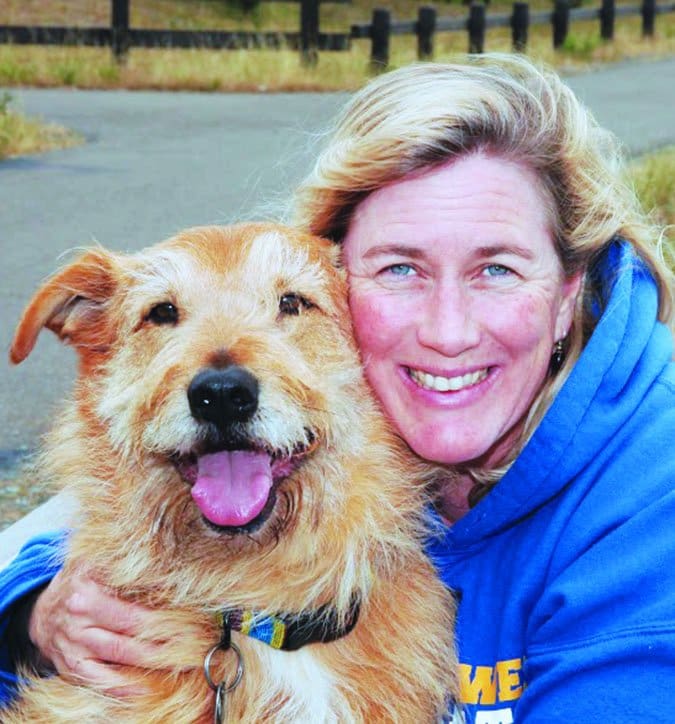
Watching him grow into lanky adulthood as my nine-year-old dog, Otto, matures into an elder statesman, is another contributing factor to my sense that time is passing over-quick. They grow so fast, and they don’t live long enough!
But, boy, am I grateful that I’ve had the collective wisdom of all of the past 20 years’ worth of Whole Dog Journal writers and contributors to draw on for help and guidance as I raise and train my dogs, as well as an all-too-steady stream of needy foster dogs. How else would I know how to make Woody vomit up things he shouldn’t have swallowed (four times already this past year!)? Or how to deal with his copious and deadly emissions of noxious gas?
Or why my super-socialized, gregarious puppy suddenly started growling and raising his hair when he meets certain new people? (Look for an article on the “adolescent fear period” in an upcoming issue of WDJ; we haven’t explicitly covered the topic before, but I’m tapping our experts to make sure that I – and you, of course! – will soon know everything a dog owner needs to know about this apparently common but unpredictable phase in canine development.)
And all the articles on caring for senior dogs, such as long-time Whole Dog Journal contributor CJ Puotinen’s piece in this issue? I’m beholden to all the experts who have contributed to this treasure trove of advice, as I do everything in my power to make sure my beloved Otto stays active and happy as long as possible.
I don’t know exactly where 20 years has gone, but I do know that I’m just as excited as I was two decades ago about “what’s next” in Whole Dog Journal. I hope you are, too!
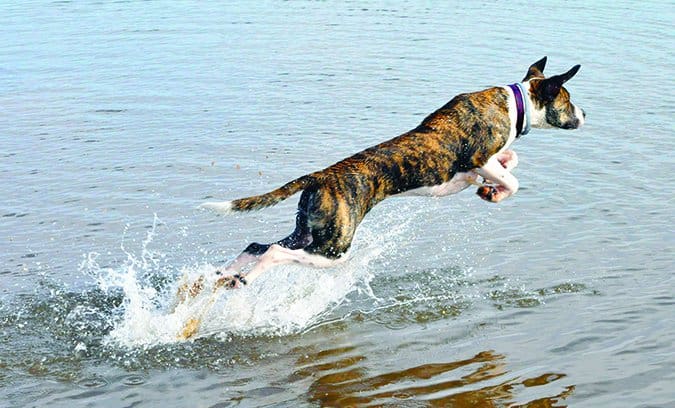
The Many Causes of Kennel Cough
[Updated February 1, 2018]
Recently, I adopted a pup from my local shelter. The little guy was about 10 weeks old, had just been neutered, and was ready to get out and about and get socialized! I was looking forward to starting this process, because he was such a calm pup . . . or was he? I started to wonder if Tico’s lack of energy might be due to illness.
Sure enough, within a day or two of coming home with me he started coughing and developed a slightly elevated temperature. Diagnosis: Canine infectious respiratory disease (CIRD), also known as infectious canine tracheobronchitis (ITB), and far more commonly known as “kennel cough.”
For my pup’s “uncomplicated” form of kennel cough, the diagnosis was made based on his history of recent exposure to the disease in the shelter environment and his characteristic clinical sign of a honk-like paroxysmal cough. These coughing “fits” can occur in spasms of 10 to 15 or even 20 coughs in a row.
Typically, clinical signs of infection will appear three to 10 days after exposure; he was right on target at five days. As with the human’s common cold, the disease is often self-limiting. Kennel cough may resolve without treatment in a week or two, or it can worsen and require veterinary attention in order to help the puppy or dog bounce back.
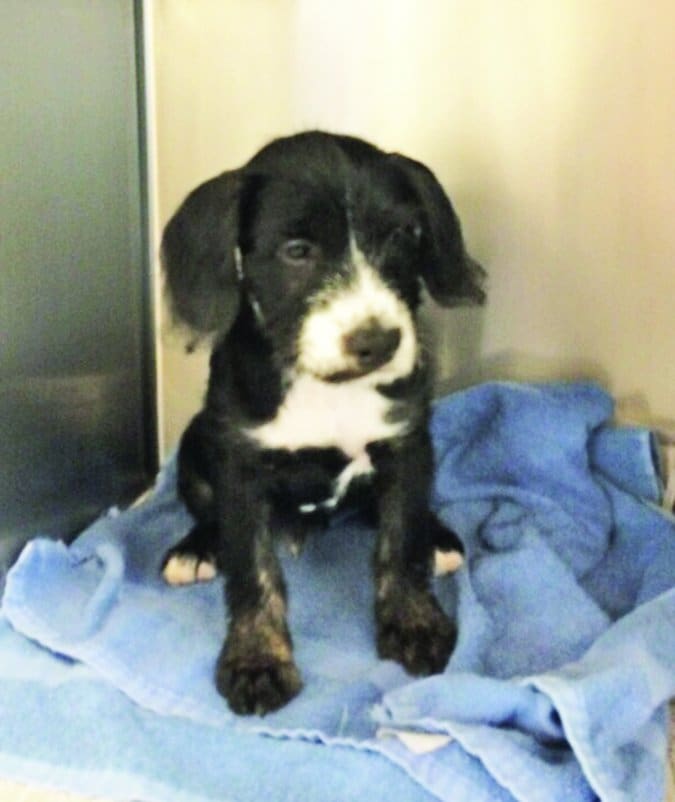
Dogs with the uncomplicated form of kennel cough tend to be otherwise healthy and continue to eat, drink, and play. Their lungs will usually sound normal, but some may experience lethargy and have a slight fever like my young pup. Others may experience nasal discharge and sneezing; still others exhibit only a persistent cough – sometimes dry and hacking, or soft and wet. Excitement, exercise, and changes in temperature or humidity can induce coughing, as can pressure on the trachea, such as from a collar.
A small percentage of infected dogs may have no symptoms at all yet still shed the virus and spread the disease.
But here I had a pup who was still in the critical period of socialization. I knew I had to keep him isolated, but his socialization window was closing fast. Besides, I had already paid for a puppy class that was due to begin in three weeks.
Kennel Cough: Virus or Infection? Both?
CIRD may be associated with an infection from a single virus, bacteria, or it may have a multi-agent etiology. Both the viral and bacterial causes present with similar clinical signs so they are commonly grouped as “kennel cough.”
Very often, a viral pathogen is its primary agent, infecting the epithelium within the upper respiratory tract and causing damage to the tissues. This, in turn, predisposes the dog to invasion by bacterial, fungal, parasitic, or other virulent organisms. This can result in a secondary infection, causing further damage and clinical signs such as inflammation in the nasal passages (rhinitis), trachea (tracheitis), bronchial tubes (bronchitis), and the smallest airways in the lungs, the bronchioles (bronchiolitis).
The inflammatory response results from the disease replicating inside the cells of the respiratory tract, from the nasal lining to the terminal airways.
The two most common forms of infectious agents are bacterial: Bordetella bronchiseptica and several species of Mycoplasma (including Mycoplasma pneumonia), gram-negative bacteria that lack a cell wall. Identified in 1910, B. bronchiseptica is closely related to Bordetella pertussis – the pathogen in humans that causes pertussis (whooping cough), which also has a very distinctive cough as a clinical sign. B. bronchiseptica can infect a number of animals, including dogs, pigs, rabbits, cats, horses, and even seals, causing a range of pathologies. There are at least 15 different species of the bacteria known to infect canines.
The most common viral pathogens that can cause “kennel cough” include canine distemper virus, canine para-influenza virus type 2, canine respiratory coronavirus, canine adenovirus type 2 and canine herpes virus. Other pathogen possibilities include canine pneumovirus, canine bocavirus, canine hepacivirus, and Streptococcus zooepidemicus. Titer tests check for all of these viruses.
While there are no genetic factors or breed predilections with CIRD, it is theorized that brachycephalic breeds could be at a higher risk factor for more severe infection. Their short and narrow respiratory tracts, combined with longer soft palates that may obstruct their respiratory tract, may contribute to the retention of pathogens in the airway, causing re-infection.
Vaccinations for Kennel Cough
Given the number of possible causative agents, the CIRD complex, almost by definition, is not a vaccine-preventable condition. That said, the Bordetella vaccine is often required by facilities prior to boarding and daycare. There are three forms of the vaccine: injectable, oral, and intranasal. One recent study found the intranasal vaccine (when compared to the oral vaccine) conferred superior clinical immunity (though both resulted in significant disease sparing).
NOTE: Vaccination prior to potential exposure can prevent infection to the specific strains of Bordetella present in the vaccine, and may help reduce the severity of related infections, but protection against all the other pathogens that can cause CIRD is not guaranteed. Just as the human flu vaccine can’t protect a person from all flu strains, neither can the Bordetella vaccine protect against all CIRD pathogens.
How Do Dogs Get Kennel Cough?
CIRD is highly contagious, infectious, and is transmitted through direct and indirect contact between animals, through contact with aerosolized respiratory secretions (coughing and sneezing) from infected dogs, and through contact with contaminated objects – just like a cold at a daycare center!
Any situation that brings dogs together increases the risk of the dispersion of this communicable disease; accordingly, it tends to spread among dogs housed in kennels and shelters. Dog owners whose dogs are coughing or showing other signs of respiratory disease should not expose their dog to other dogs or take them to places where other dogs congregate (dog parks, training classes, boarding facilities, etc.).
That said, some dogs have been known to become infected following well-pet visits to a veterinarian, doggie daycare, or training class. A dog or puppy can be infected and shed a virus (that can infect other dogs) before his owner has noticed any symptoms! Some infected dogs never show signs of illness, even as they infect other dogs and puppies.
If infection spreads within a kennel or facility, it can be controlled. All items that have come into contact with an infected dog should be cleaned and disinfected after exposure. Generally, ridding a facility of the virus requires evacuating the premises for one to two weeks and disinfecting with commonly used chemicals, such as sodium hypochlorite (a.k.a. liquid bleach at 1:30 dilution), chlorhexidine, or benzalkonium. Though it can hurt financially, boarding kennels that have experienced an outbreak of kennel cough may be able to close long enough to stop new infections. But few if any shelters can completely close for a week or more, and while most will do the best they can do to disinfect their facilities without closing, agents that cause kennel cough can almost always be found in shelters.
When I brought my “calm” but not yet outwardly symptomatic pup home, he was already infected. My sister (who works at the shelter I adopted him from) had taken him to her own home before mine, and he was mostly likely shedding the disease while around her two dogs.
However, neither of my sister’s dogs developed the disease. They were adults (two and four years of age), and had come from the same shelter as my pup; it’s possible that they are immune to the causative agent of Tico’s infection, having been infected with it as puppies from that shelter years prior! Typically, healthy dogs in a home will only develop mild, if any, signs of CIRD after exposure to an infected dog.
CIRD affects dogs of all ages. Puppies less than three months old are more susceptible and the disease tends to be most severe in puppies who are six weeks to six months of age. In very young puppies, maternal antibodies (provided the mother has them herself) should protect the puppies until they are about three to four weeks of age.
Other high-risk dogs are those who are immunosuppressed, dogs without a history of vaccination or disease exposure, pups who lack maternal immunity (did not receive colostrum in the days after birth, or whose mothers had neither a history of vaccination or disease exposure), and dogs who have coexisting subclinical airway disease (such as a congenital anomaly, chronic bronchitis, or bronchiectasis – a chronic condition where the walls of the bronchi are thickened from inflammation and infection).
It is suspected that the disease presents in a seasonal pattern with a higher incidence in cold months due to pathogens surviving longer in cold and wet environments.
How to Treat Kennel Cough at Home
Adult dogs can, and probably most often do, recover from kennel cough with no treatment at all. Strong, healthy puppies raised in homes, too, often recover uneventfully and without treatment. But some puppies and dogs need a little help, even with a relatively uncomplicated form of the disease.
The medications of choice for the initial treatment of the uncomplicated form of CIRD are amoxicillin/clavulanic acid and doxycycline (usually for a three-week period); patients should respond to treatment in 10-14 days. My pup ceased coughing within two weeks, clearing the requirement set by the class instructor of being cough-free for a week prior.
As the cough can be quite loud and bothersome – for humans and dogs – a cough suppressant may be prescribed by your veterinarian. Restriction of exercise and prevention of excitement may shorten the course of the disease due to the reduction of irritation.
What else can you give a dog for coughing?
Many natural remedies are available to help dogs fight kennel cough. See, “Kennel Cough Treatment and Prevention for Dogs,” for holistic kennel cough treatment options.
If the dog continues to cough for more than 14 days, the diagnosis of uncomplicated disease might need to be reevaluated. In otherwise healthy dogs, parasitic bronchitis, irritant tracheobronchitis, tracheal foreign body, and tracheal collapse may need to be ruled out.
Complications from Kennel Cough
The complicated, or severe, form of CIRD tends to manifest in dogs in the at-risk category. In addition to the clinical signs apparent with the uncomplicated form, the dog may also exhibit a fluctuating fever; inappetence or anorexia; exercise intolerance; dyspnea (difficult or labored breathing); increased intensity of normal lung sounds, with crackling or wheezing, often presenting with pneumonia. In these cases, CIRD can be life-threatening, especially in very young puppies and those who have had a rough start in life (like many puppies who are brought to shelters at a too-early age, with already compromised health).
In severe cases, thoracic radiographs may show lung patterns typical of bacterial or viral pneumonia; a complete blood panel may indicate early mild leukopenia (5,000-6,000 cells d/L) suggesting a viral cause, and neutrophilic leukocytosis (a high number of immature white blood cells, indicating an infection or inflammation) is frequently found in cases of severe pneumonia.
With suspected severe disease cases, a tracheal wash or tracheobronchial lavage may be performed to gather a sample at the site of infection; then the sample can be cultured in order to identify the pathogen and devise an effective, targeted treatment plan.
Medications of choice for severe disease are first generation cephalosporin with gentamicin, amikacin, or enrofloxacin. These are usually effective with antimicrobial therapy continuing 10 days beyond radiographic resolution of the disease.
Be aware that cough suppressants are contraindicated in patients with pneumonia. Fluid administration may be indicated for complicated disease and/or pneumonia, and the puppy should be on enforced rest for at least the duration of radiographic evidence of pneumonia. Radiography should be repeated at least 14 days beyond resolution of all clinical signs; the typical course of severe disease is two to six weeks.
Though rare, dogs can die from CIRD, but those cases are usually a result of severe pneumonia affecting multiple lung nodes.
Knowing that my puppy’s infection was most likely due to the prevalent mycoplasma at his shelter of origin, I opted to ask my veterinarian to consider prescribing a course of antibiotics, with the hope that Tico would be cleared in time to attend class. Happily, my veterinarian agreed this was a good plan, and Tico recovered fully in time to participate in puppy kindergarten.
Can Humans Get Kennel Cough?
Most of us who have worked in shelters joke about having kennel cough any time we have a cold. The vast majority of the time, it’s just that – a joke. It’s rare, but immunocompromised humans CAN be infected with Bordetella bronchiseptica. If someone in your family is immunocompromised, please check with that person’s physician before bringing home a sick puppy (or one who was recently exposed to the illness an at animal shelter).
And be aware that B. bronchiseptica can be transmitted between dogs and cats! Epidemiological studies have shown that cats who have contact with dogs with recent respiratory disease were found to be at risk for B. bronchiseptica infection, and if infected, can develop upper respiratory tract infections.
Best Dog Gear of the Year: 2016
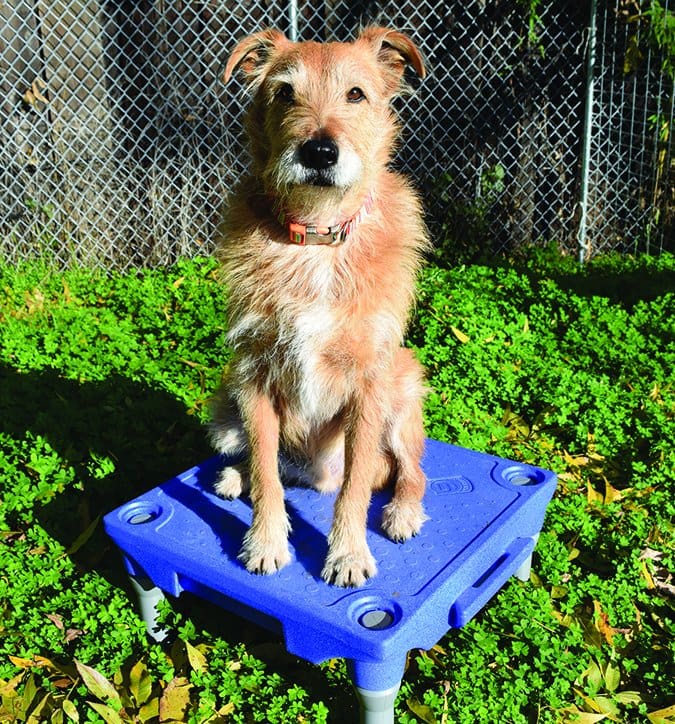
The Klimb
“Seriously?” you may say. “That little plastic platform gives you joy?” Oh, yes, it does! And I’m not the only one who gets carried away. The Klimb is described by its maker as “the world’s first professionally designed and engineered dog training platform . . . specifically designed to improve the relationship between you and your dog.”
Put plainly, it’s just a piece of equipment for dog training, but it’s an extraordinarily well-made, sturdy, stable piece of equipment that dogs feel very confident about jumping, standing, sitting, and lying down on. What’s more, it can be connected to other Klimb platforms by virtue of clever interlocking shapes on the Klimb edges side, and securely stacked on other Klimbs without getting wobbly. Its surface is rubberized, to prevent slipping, and Blue-9 offers little rubber “safety plugs” (sold separately) that can cover the leg openings of the top-most Klimb to prevent any dog from so much as catching a nail. They’ve thought of everything!
“Platform” or “station” training is all the rage these days, as owners discover the benefits of giving their dogs a secure, easily defined spot to remain within while they work on anything from tricks to show ring obedience moves (such as alternating between sit, down, and stand in the heel position). The Klimb offers a secure, durable place for training. And it’s handy for handlers, too. Each Klimb weighs just 14 pounds, and measures 24 inches square. Used without legs, the platform is four inches high; the standard legs that come with it make the platform 12 inches high (six-inch legs are sold separately). The legs can be removed and clipped into storage slots on the bottom of the platform. The Klimb is available in three colors: black, blue, and purple.
For training ideas and tips, see the Blue-9 website. But watch out! You may catch yourself smiling, and then ordering a Klimb or two for your dog’s training program!
The Klimb – $160
Blue-9 Pet Products
Maquoketa, Iowa
(563) 293-5999
Inject-N-Clean
Relax! Despite the name and the needle-like appearance, it’s not drug paraphernalia. But what it can do for your carpets might alter your reality.
This product is designed to allow you to deliver stain- and odor-neutralizing products to the place you’ve never been able to deliver them before: under a saturated carpet!
The product was invented by a carpet installer, who couldn’t help but notice (as he removed stained carpets and the stinky padding underneath them, prior to installing new carpets) that pet owners can’t ever seem to completely eliminate stains and odors when their pets have accidents indoors. If only there was a way, he thought, to inject odor neutralizers where spot cleaners and even high-powered carpet cleaners can’t reach. His solution was Inject N Clean. The sharp metal needle is pushed through the carpet in the middle of the “accident site,” and then paired with a custom-fit squeeze bottle. The operator uses the ball on the injector to pull the carpet up slightly, so when the bottle is squeezed, the odor-neutralizing fluid is sprayed right on the odor’s source.
Inject-N-Clean – $25
Inject N Clean
Dundas, Minnesota
(800) 645-4415
Pendleton National Park Dog Beds
In commemoration of the 100th anniversary of the National Park Service, Pendleton and the Carolina Pet Company teamed up to produce a line of pet products with a National Park Service theme. Pendleton created a beautiful color palette and design for 11 different park-themed collections – not just dog beds, but dog coats, collars, leashes, travel bowls, and matching Pendleton blankets for dog dads and moms. It’s the beds, though, that we feel most joyful about.
And how not? Look at those colors!
The Pendleton beds are covered with a non-pilling Polarfleece fabric, and filled with 100 percent polyester fiber made from recycled soda bottles, arranged in chambered liners to maintain a loft that elevates dogs off cold floors (the bed is approximately four inches thick). The bottom fabric is a diamond-quilted cotton canvas. The cover is removable and machine washable.
The beds are sold in four sizes, from small (28 by 20 inches) to extra large (48 by 36 inches).
Face it: Few dog beds are all that attractive; it’s a challenge to find some that actually improve one’s decor. But here they are! A percentage of the sales of these products will be donated to the National Parks Foundation. That might be our excuse to decorate our home with these beautiful dog beds – and maybe some matching throw blankets for the couch!
Pendleton National Park Dog Beds – $100-$170 depending on size
Made by Carolina Pet Company
Prosperity, South Carolina
Sold by Pendleton in stores and online and at independent pet supply stores. We found the best prices at Frontgate.com.

Pupsaver
The first time we saw PupSaver – a car safety seat for small dogs – we thought it was being displayed backward. Then we spoke to a company representative and got the scoop. The PupSaver seat is designed to work just like a backward-facing infant seat, preventing (in this case) small dogs from being thrown forward in an accident.
Most car safety devices for dogs are comprised of some sort of harness that is worn by the dog and is strapped to the car as tightly as the dog can endure. AirPupSaver is more like an exceptionally durable pre-inflated air bag, that will contain and cushion a dog who is flung by the force of a crash. The dog is kept in the seat with a harness, but it’s not the harness – or the dog’s body – that will absorb the energy of an impact; instead, it’s the air bag contained in the AirPupSaver seat that will act as a protective barrier to prevent him contacting any hard surfaces in the event of a collision.
The development of PupSaver started with products designed for tiny and small dogs; today, the company makes seats for dogs up to 45 pounds. The seat is available in three styles: Original PupSaver (which is cushioned with polyfill and contains no air bag); and the AirPupSaver 25 and AirPupSaver 45, which are made with air bags and are fastened with heavy-duty metal hooks for lower latch (child safety seat) anchors in the back seat (the numbers 25 and 45 indicate the maximum weight of the dog the seats are intended for).
The PupSaver seats were crafted by a safety design engineer with 20-plus years experience in child safety seat design, and all of the products have been subjected to rigorous crash testing at the MGA Research Corporation. Videos of the crash tests can be viewed on the PupSaver website.
PupSaver seats are ideally positioned in the back seat of a car. However, recognizing that many dog owners prefer to have their dogs in the front seat, the company has issued guidelines for using the Original PupSaver and the AirPupSaver in the front seat, and says that if used according to instructions (including moving the seat as far back as possible and making sure the dog is snugly fastened in the seat), the PupSaver would protect the dog from being injured by either the crash or the car’s air bag. No other existing car safety product protects a dog from being hit by a car’s air bag in the event of a collision.
Pupsaver – $120-$180 depending on size and model
PupSaver
Cumming, Georgia
(844) 728-7787
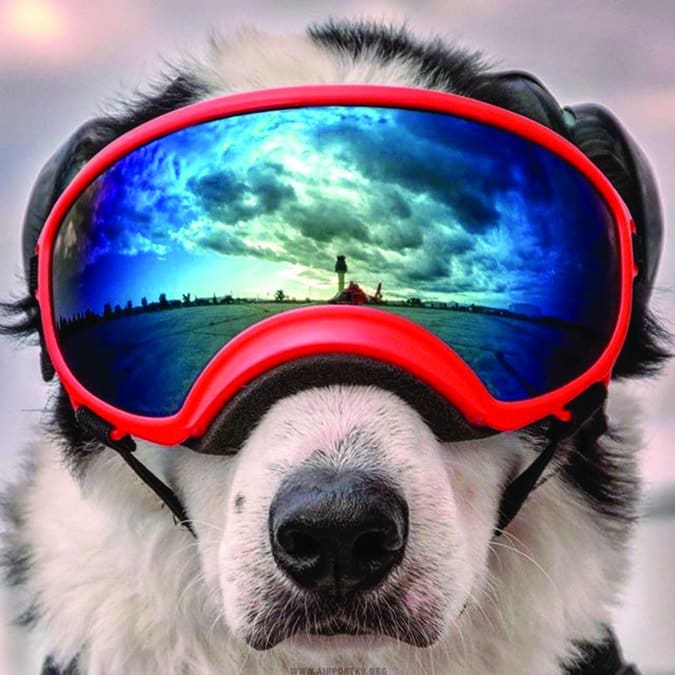
Rex Specs Dog Goggles
These dog goggles are seriously cool – and seriously pricey – but most of all, they are for serious dog activities. They have been used to protect the eyes and vision of military dogs who jump (with their handlers) out of airplanes and helicopters, scent-detection dogs on Coast Guard vessels, and search and rescue dogs who are being transported in the backs of trucks or other rough-terrain vehicles.
But people who have serious fun skiing or sailing with their dogs have also found Rex Specs to be helpful for blocking out damaging UVA and UVB rays.
Thee durable frames are edged with soft foam, so the Specs fit comfortably. The dynamic strap system ensures a secure fit while allowing for full jaw motion and zero interference with the dog’s nose or ears. All the polycarbonate (shatterproof) lenses are interchangeable, and available in clear and smoke-tinted versions, and reflective or matte finishes.
The Rex Specs website features instructional videos and diagrams, to help you order the right size product, fit it on your dog, and then accustom him to wearing the protective gear.
Rex Specs Dog Goggles – $80
Rex Specs
Jackson, Wyoming
(307) 203-0308
Tether Tug
The photo below pretty much describes and sells the product, but if you aren’t convinced your tug-loving dog is going to have fun with this product, go to the Tether Tug website and watch the videos of dogs having a blast!
The Tether Tug is a durable, interactive toy designed to provide your dog with hours of fun and safe play, even (possibly, depending on your dog’s energy level) when you’re not around!
The toy comes in six sizes, each with an amount of flexibility and strength appropriate to the size of the dog its intended for. The rope that the dog pulls on can be replaced; Tether Tug also sells a braided fleece rope ($10) for puppies and dogs with softer mouths. The Quick Connector allows toys to be easily swapped to fit any dog’s preference.
An indoor model, meant for small dogs and puppies, comes with a heavy metal base that you secure by placing it under a heavy sofa or table leg.
The outdoor Tether Tug is easy to set up. Simply drive the metal base into the ground, insert the 55-inch Tether Tug into the base, attach a Tether Toy and your dog is ready to play! The company also sells extra in-ground bases (just $8), so you can change locations without having to dig up the base each time.
The pole and rope part of the toy can also be used in hand as a tug toy and “flirt pole,” encouraging your dog to run and chase.
Not only does the company guarantee that Tether Tug will be fun for you and your dog, they also guarantee the toy. If you purchase it directly from the company and it breaks, they will either replace the product or refund your money.
Tether Tug – $50-$65 depending on size
Tether Tug
Springfield, Missouri
(888) 458-5759
RhinoPlay Toys
It’s rare to find a toy with something altogether new to offer. When we first spotted the RhinoPlay toys at a pet products show, we very nearly just walked right on by, because they didn’t look that different. But as we passed the Go Dog (manufacturer’s) booth, we happened to run our hands across one of the toys on display, and had to stop and do a double-take. Hey! What’s this?
These toys are made of a unique material that Go Dog calls PopFoam NT, a nontoxic, long-lasting, durable, lightweight substance. It has what our dogs regard as the perfect texture to the tooth; when chomped on, it gives a little, puncturing slightly, but resists being chewed up! Go Dog describes them as deceptively light, and incredibly strong, and that’s been our experience with them. Fun stuff!
Even better, the company says the manufacturing process of the toys is environmentally friendly, and the products are all certified as nontoxic. In fact, they meet children’s safety standards EN71 and ASTM-F963. So there!
Go Dog makes four RhinoPlay toys, and each is offered in two sizes (small and large): Vexo is a stick-like toy; Cirq is a sort of donut-shaped creation; Flip is a flying disc that has an irregular shape, which makes it easy to pick up off the ground; and Beast is a self-inflating ball that never goes flat, even when it’s punctured.
If you’re in a store where these are sold, don’t miss the opportunity to touch one; you will immediately understand the appeal. And if you can’t find them stores near you, order one online. You’ll be happy you did!
RhinoPlay Toys – $11-$19
Go Dog, a division of Quaker Pet Group
Denver, Colorado
Sold in select independent pet supply stores and online. For locations, go to QuakerPetGroup.com.
My Dog Nose It Sunscreen
Skin cancer isn’t just on the rise in humans, it also affects our pets, especially dogs with white hair and pink skin, thin-coated dogs, and hairless breeds.
Fortunately, My Dog Nose It offers natural, safe, water-resistant UVA and UVB sun protection for these especially vulnerable dogs, and all vulnerable dog noses and ears. The product is alcohol-free, pH balanced, non-greasy, and proudly made in the USA.
My Dog Nose It Balm has a creamy texture, which dries quickly, even as it heals and adds moisture to dry, cracking, or fading dog noses. It comes in a half-ounce jar, which is estimated to last about four months if used daily on an average-sized dog’s nose! My Dog Nose It Body and Coat Spray comes in a four-ounce non-aerosol spray bottle. Both products are free of zinc oxide and titanium dioxide, which are present in many human sunscreens and are toxic to our pets!
My Dog Nose It Balm – $13
Body & Coat Spray – $20
My Dog Nose It
Seal Beach, California
(888) 444-5044
Teach Your Dog to Fetch By Training Your Dog to Love Retrieval
As any puppy owner knows, dogs are naturally oral creatures. Seems like a retrieve should, therefore, be an easy behavior to teach. Indeed, it sometimes is, but as many dog owners know, it often is not. Reasons a dog might not fetch naturally include:
1. The dog was punished as a puppy for picking up/chewing on things and therefore his oral tendencies have been suppressed.
2. The dog has been chased for picking up things and therefore plays keep away instead of bringing things back.
3. The dog is of a breed that has not been genetically programmed to bring things back to their humans (think terriers versus sporting and herding breeds).
There are many reasons to persevere in teaching even the most reluctant retriever to retrieve, however. A dog who retrieves can:
1. Be easily exercised and amused with long sessions of fetch in the backyard, or even in the house in inclement weather. Exercise is a great behavior modifier; a tired dog is a well-behaved dog – and makes for a happy human.
2. Learn to find and bring back lost objects.
3. Compete in obedience trials and other canine competitions.
4. Learn to do other things with his mouth, including service dog-type behaviors such as opening doors, picking up dropped objects, pulling wagons, carrying groceries, removing items of clothing, and more.
5. Engage in cognitive activities such as object and location discrimination.
When a dog loves to retrieve, the behavior can be used as a powerful non-food reinforcer, as well as a tool for keeping the dog’s attention around distractions, and for getting really sharp recalls and other operant behaviors. A highly valued tennis ball can be a great reinforcer – for some dogs, a ball is even more valuable than food! – for spiffy recalls and downs, among other behaviors. These are all great reasons to help a dog love to retrieve!
Formal Dog Retrieval and Informal Fetch
There are different types of retrieves. The majority of dog owners are happy with a dog who dances in anticipation of the ball, chases after it the instant it’s thrown, maybe runs around with it for a bit, then eventually brings it back at and drops it at the owner’s feet. We’d call this an informal game of fetch.
Compare that to a formal show retrieve, where the dog is supposed to sit motionless in perfect heel position while the owner throws a dumbbell, dash forward when the owner gives the cue, grab the dumbbell cleanly by the center bar, return quickly to the owner, and sit in front, perfectly straight, waiting for his owner to give the cue to release the object carefully into her outstretched hands. “Canine Sports: Competitive Obedience,” (July 2010) goes into greater detail on what is required for the show ring.
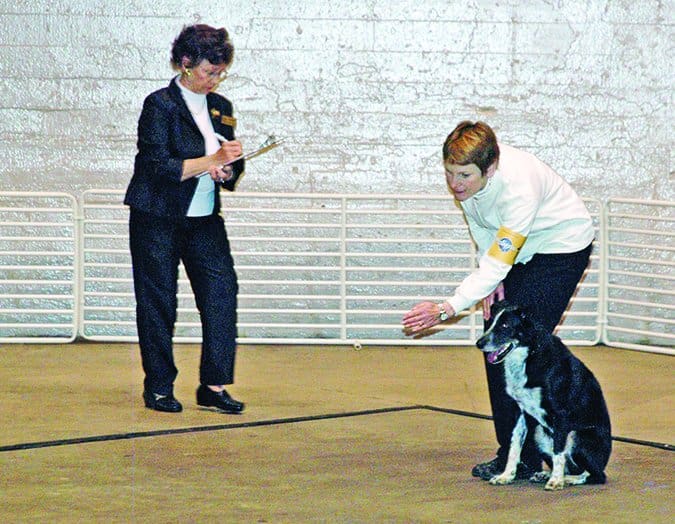
Even if you’re not interested in a formal retrieve, consider taking advantage of a good game of fetch as an opportunity to reinforce good manners behavior. Consistently ask your dog to “sit” before you throw the ball, until he starts offering to sit without being asked. “Sit” makes good things happen! It’s also a deference behavior, and good “self-control” practice. When he’s consistently offering a calm sit before you throw the ball, try building a similar routine to get him to offer a calm “down” before you throw the ball.
You can also use a valued fetch toy to install an off-switch for your dog. When it’s time to stop the game, use a cue like “All done!” or “That’s all!” and immediately put the ball where he can’t see it, such as in a pocket, a drawer, or a cupboard. Turn and walk away – totally ignoring any attempts on the dog’s part to re-engage you in the game. In time, your “All done!” cue will not only serve notice to your dog that the fetch game is over, but also indicate the end of other behaviors.
Whether you’re interested in an informal fetch or a formal retrieve, your task will be easier if you encourage rather than discourage retrieve-related behaviors early in your relationship with your dog. When he has something in his mouth, praise him; tell him he’s a good dog! If it’s something he’s allowed to have, you can sometimes praise him and let him be, and other times, you can say “Trade!” and trade him a treat for the item. Or, trade him a treat for the item, and then give him the item back again. That’s quite a reward!
But if, in contrast, he has something in his mouth that he shouldn’t have, cheerfully trade him for a high-value treat, divert his interest to a “legal” toy, and make a mental note to increase your management efforts to minimize his access to those things you don’t want him to have.
Shaping Your Dog’s Retrieve
Whether your dog is a natural retriever or not, the training process is the same. It’s just a matter of shaping the retrieve you want. If you’re going for a formal retrieve, it’s a matter of chaining or backchaining the “fetch” behavior into the whole show-ring retrieve routine. (See “Fun Dog Training Techniques Using Shaping,” (March 2006), and “Beyond Basic Positive Dog Training Techniques,” (April 2004).
Since the “hold” tends to be the most challenging part of the retrieve, we’ll start with shaping that behavior and work our way backward (backchain) to the completed fetch behavior.
You can indicate to your dog precisely which behavior will result in his receiving a treat or other reward by “marking” the moment with a clicker, using your mouth to make a clicking or clucking sound, using a verbal marker (such as the word “Yes!”), or by using an i-Click (a clicker with a raised button), positioned so you can click it with an elbow or a foot. Just be aware that if your clicker is in your hands, you may frighten your dog by clicking too close to his face. You definitely do not want to give him an aversive association with the retrieve game!
Remember, each time you mark a behavior, you need to deliver a treat pretty quickly afterward. The marker is a promise that a reward is on the way, and it gives the dog solid, instantaneous information about what behavior he can repeat in order to earn more rewards.
In Whole Dog Journal, we often use the phrase “click/treat” or “mark/treat” as shorthand for using a marker of any kind and then giving the dog a food reward.
Okay, ready? Designate your dog’s most favorite toy as his fetch object. Hold it in both hands and offer it to him, rather than throw it. If he sniffs it, mark that desired behavior with a click! (or your alternate marker) and give him a reward. If he merely glances in the object’s direction, mark the glance and give him a reward.
In the beginning, reinforce your canine pal just for paying attention to the object. In any series of “attention” trials with the fetch toy, sometimes he’ll sniff or touch it, sometimes he’ll just look at it, and sometimes he’ll put his mouth on it. Once he understands the game, you can up the ante (this is called “raising the criteria”); you mark the behavior and give him a treat only if he touches it. Then, later, you mark/reward only if opens his mouth (even slightly), and eventually, only if he actually puts his mouth on it, then for longer periods of “mouth on object.” (Of course, he will let go of the object to eat the treat after you click or use your alternate marker!)
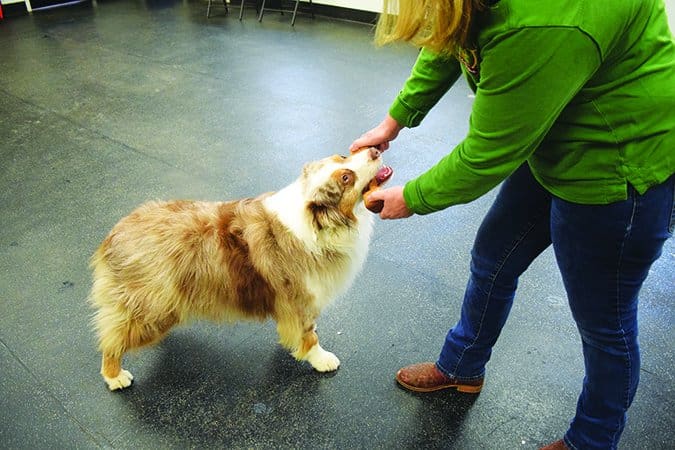
When he will hold his mouth on the object for five seconds or longer, briefly remove your hands and then grasp the object again. Mark the behavior and give him a treat when your hands touch the object. Repeat, gradually increasing the length of time your hands are off the object. Remember to mark/treat when you replace your hands on the object.
The next step is to move your hands a few inches away from the object, and click/treat your dog for moving the object to your hands, eventually increasing the duration the object is in your hands before you mark and reward this behavior. The duration of the hold is important for a solid retrieve! When you have several seconds of duration, start varying the duration so your dog doesn’t anticipate the release and let go too soon.
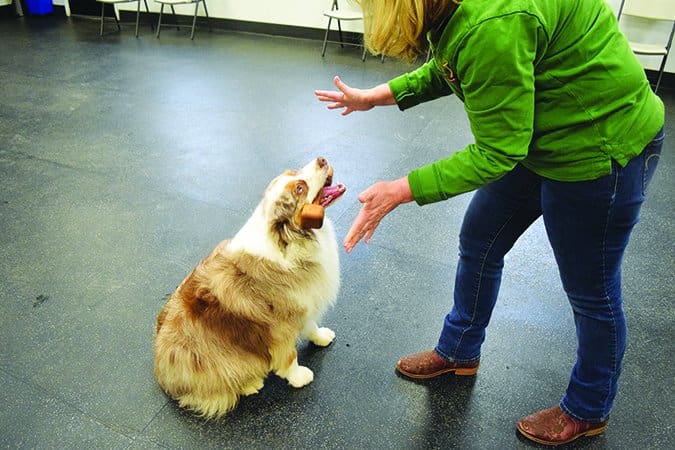
Now place the article on the floor with your hands on it. If you’re lucky, your dog will transfer his mouth/hold behavior immediately to the object on the floor. If not, back up and use the same shaping process you just used to get the dog to hold the article to get him to put his mouth on it on the floor. (With the article on the floor, click/treat him for looking at or sniffing the article, and build again from there.) When he will mouth the object, move your hands a few inches away, and have him deliver it to you. Remember to vary the amount of time (duration) that you hold your hands on the object before you click/treat.
Next, gradually increase the distance between the article on the ground and your hands until your dog is picking the object up and delivering it to you from a few feet away.
(Have you noticed that I haven’t told you to add any cues yet?)

Next, start tossing the article a few feet and letting your dog go get it and bring it back. After a few successful toss/retrieves, ask your dog to wait (hold him gently if necessary) while you sometimes place, sometimes toss the article a few feet away. Return to his side, wait a few seconds, then release him to retrieve the object. (Vary the duration that you wait before releasing, just as you continue to vary the duration of the hold before you click and treat.)
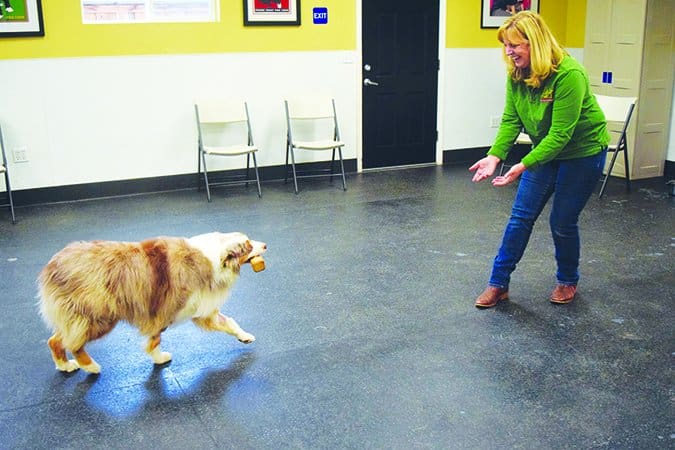
When your dog is routinely picking up the object, bringing it back to you, and reliably holding it until you click/treat, add your verbal cue of “Fetch,” “Take it,” “Get it,” or whatever you plan to use. First give the cue just as the object touches the ground. When he will reliably dash out to get it and bring it back, add the “Wait!” back in (hold him if necessary), and vary the amount of time between the toss and the “Fetch!” cue.
You’re almost done. The next step is to add your “Give” cue to replace your marker (click, “Yes!” or what have you) as his signal to let go of the object. It’s important to continue to vary the duration of hold after your hands touch the article, as it’s easy for hands-touching-article to become a default cue to release – and you don’t want that! When your dog retrieves the object, grasp it with your hands, wait, say your “Give!” cue, and then click/treat.
Eventually – probably pretty quickly – you will be able to fade the marker and your dog will release the object on cue. At this point, if you’ve done your job well, your dog will love retrieving so much that you can reinforce the retrieve with the opportunity to fetch again.
The final step is to generalize the retrieve to other objects. Start back at the beginning of the shaping process as needed and work your way (probably much more quickly with each new object), first with other toys and articles the dog is likely to pick up, and eventually with more challenging objects like your keys and the TV remote.
Don’t forget to keep it fun! This should be the best game in the world for your dog. If at any time he “quits” – that is, he stops playing the game – you may have raised the criteria too quickly, or you may have trained for too long. Training sessions should generally be five to 15 minutes in length, several times a day (although some dogs have a strong work ethic and will happily work longer). Remember that it’s always better to stop when you and your dog are having fun and winning, rather than when one or both of you are bored, tired, or frustrated.
Teaching Your Dog a Cognitive Retrieval
For a real training challenge, add a cognitive piece to your dog’s retrieving abilities: object discrimination. Name each new object as you add to his repertoire of fetchable items. As you present it to him, use the object’s name. “Ball.” “Kong.” “Frisbee.” “Snake.” You will need to get creative with names as you add more objects to his list – and write them down so you don’t forget them. Then, when you give your “Fetch” cue, also name the object that you are asking him to retrieve. “Ball, Fetch!” “Snake, Fetch!” “Frisbee, Fetch!”
When your dog’s retrieve is very solid with individual named objects, you’re ready for the cognitive part. Place one object (say, a Frisbee) a foot away from him. Place another object (say, a snake) about six feet away. Cue him to “Frisbee Fetch!” (the closer object). As long as he retrieves the correct object, gradually move the closer object (in this case, the Frisbee) farther away, until it is also six feet away from you – and several feet to the side of the other toy (in this example, the snake).
If he starts making mistakes, you’ve moved too quickly. Bring the Frisbee back closer and continue. When he is at least 80 percent reliable with the Frisbee and the snake, put those two items away and bring out two more. Repeat the same routine – one close, one far away, until he’s getting it right. As he gets better at it and understands the concept of objects having names, you can add multiple objects and ask him to get one, then a different one. Take it slow! This is PhD work for you and your dog.
Want another cognitive retrieve challenge? Teach your dog the names of the rooms in your house. Take him into the kitchen and say, “Kitchen!” Repeat several times. Then stand outside the kitchen, say “Kitchen!” and run with him into the kitchen. Click and treat. Repeat until he will run into the kitchen without you when you say, “Kitchen!” Now repeat with other rooms in your house until he will run to any room you name. Next step: Add the retrieve. Have him wait outside the kitchen, and set the ball in the kitchen where he can see it. Return to him and tell him “Ball, Kitchen, Fetch!” Repeat with different objects from greater distances – and in different rooms, until he will fetch an object from any room you designate.
Want to get really fancy? When he’s really good at each of the above cognitive retrieves, combine the two. Place two (and eventually multiple) objects in another room and cue him to fetch one. Perhaps the snake and Frisbee are in the bedroom, with the snake closer to the door at first (remember to set him up to succeed!). Tell him “Snake, Bedroom, Fetch!”
With time and success, you can work your way up to object discrimination with multiple items in various rooms all over the house. Who knows, maybe your dog can rival the accomplishments of the brilliant and notable Border Collie, Chaser, who knows the names of more than 1,000 objects and can perform incredible feats of cognition. If not, the two of you will still be having a ton of fun together!
Thanks to trainer Sarah Richardson of The Canine Connection, in Chico, California, for modeling for this article.
Author Pat Miller, CBCC-KA, CPDT-KA, is WDJ’s Training Editor. She and her husband Paul live in Fairplay, Maryland, site of her Peaceable Paws training center, where Pat offers dog-training classes and courses for trainers. Miller is also the author of many books on positive training. Her newest is Beware of the Dog: Positive Solutions for Aggressive Behavior in Dogs (Dogwise Publishing, 2016).


